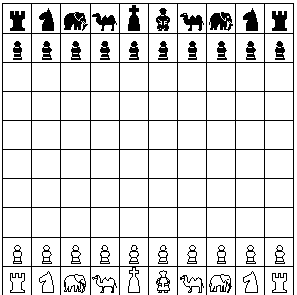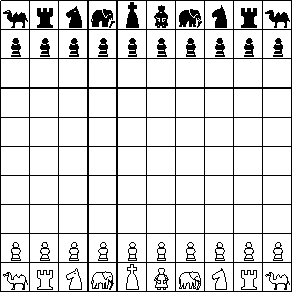Shatranj Kamil
In his Chess Variations - Ancient, Regional, and Modern, John Gollon describes this around 1000 years old variant of Shatranj. It is probably one of the first attempts to improve chess by adding new pieces and playing it on a larger board, and, as the new piece adds little to the game, one that was not very succesfull: the game was soon forgotten by the players. It was mentioned in an old manuscript, and the rules were first rediscovered by chess historian Murray and described in his History of Chess.
The name means Perfect Chess, or Complete Chess.
Rules
The game is played on a 10 by 10 board. In addition to the pieces used in Shatranj, there are two camels and two extra pawns per player.
Two different setups have been used.
 Setup
1
Setup
1
White:
King e1; General f1; Rook a1, j1; Knight b1, i1; Elephant c1, h1; Camel
d1, g1; Pawn a2, b2, c2, d2, e2, f2, g2, h2, i2, j2.
Black:
King e10; General f10; Rook a10, l10; Knight b10, k10; Elephant c10, h10;
Camel d10, g10; Pawn a9, b9, c9, d9, e9, f9, g9, h9, i9, j9.
 Setup
2
Setup
2
White:
King e1; General f1; Rook b1, i1; Knight c1, h1; Elephant d1, g1; Camel
a1, j1; Pawn a2, b2, c2, d2, e2, f2, g2, h2, i2, j2.
Black:
King e10; General f10; Rook b10, i10; Knight c10, h10; Elephant d1, g1;
Camel a10, j10; Pawn a9, b9, c9, d9, e9, f9, g9, h9, i9, j9.
Most pieces move like in Shatranj: kings, rooks, and knights as in orthodox chess (but no castling); Generals one square diagonally; Elephants two squares diagonally with the possibility to jump over the first square diagonally; pawns like usual pawns but without the possibility of a double first step. Pawns promote to generals when reaching the tenth row.
Camels move two squares horizontally or vertically, and may jump the intervening square; so white can start in setup 1 by moving his camel from d1 to d3.
A player wins the game when he mates the opponent, when he stalemates the opponent, or when he takes the last piece of the opponent except the king (`bare king'); in the last case, the opponent draws when he can also take the last piece of the other player in one move.
Written by Hans Bodlaender.
WWW page created: July 7, 1997.
